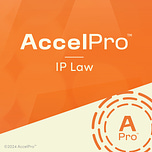Listen on Apple Podcasts, Spotify and YouTube
Welcome to AccelPro IP Law, where we provide expert interviews and coaching to accelerate your professional development. Today we’re featuring a conversation with Julie Burke, Expert Witness on US Patent Practice at IPQuality Pro.
Burke, a former patent scientist and United States Patent and Trademark Office (USPTO) quality assurance specialist and special program examiner, focuses in our conversation on the USPTO’s updated DOCX filing requirements.
We talk about Burke's paper on DOCX filing and rendering errors, DOCX filing requirements and the type of errors IP practitioners may encounter when filing DOCX patent applications in the US.
“Even though all the text is there from the beginning to the end, applicants receive a notice of missing parts with no way to move forward,” Burke says.
“This jams up prosecution for months to come, because it's taking on average 170 days for our sample of applications that have been petitioned for the Patent Office to respond. That's a very lengthy time to have your application stuck on hold in pre-exam with no way to move forward. The error itself is not one created by the applicant, but you have to file the petitions, pay the fees and wait to see if you can get it fixed.”
Listen on Apple Podcasts, Spotify and YouTube.
Interview References:
Julie Burke’s LinkedIn and IP Watchdog profiles.
3:18 | Burke, Julie and Spector, Michael. The Trains, Planes and Automobiles of Correcting DOCX-Related Errors. (19 March, 2024). IP Watchdog.
Supplemental Materials:
1001 Statutory Authority of Director of the USPTO [R-07.2015].
Burke, Julie. DOCX Plan Risks Patent Quality And USPTO Should Reverse It. (8 August, 2022). Law360.
Related Interviews from AccelPro:
TRANSCRIPT
I. INSIDE THE DOCX REQUIREMENT
Neal Ungerleider, Host: Can you tell us how the USPTO's DOCX filing requirement works and how the transition has affected IP practitioners?
Julie Burke: The DOCX initiative is, from my point of view, quite problematic for patent practitioners. It seems to be a mechanism for the US Patent and Trademark Office and the patent examiners to more efficiently handle files, but it comes at great cost for document integrity and the integrity of the underlying documents of the patent applications. As you know, they become the prior art that are searched for technical improvements and small changes made within these documents at the character level.
When this first was coming forth, I ventured out my opinion in a Law360 op-ed. I would have preferred to use the patent office text based PDF form system which is used by the US court systems. The document you file there is the document that is seen by the judges and the other side in the courtroom.
In that case, the document that's filed in front of the patent office, the PDF, is the same, character by character, as what is shown to the patent examiners. It would be the same as what's shown in the patent center official record and electronic file. The idea is that it would stay the same throughout patent prosecution and after the patent issues—we would still have the same underlying documents.
NU: Can you tell us more about the paper you wrote about DOCX filing and rendering errors.
JB: The paper is on the emerging initial snapshot of what sort of problems patent practitioners are seeing when they have tried to use the DOCX program. As an advisor to Petition.AI, I have the benefit of being able to access the database and look at patent office, prosecution petition decisions, and associated documents.
The intent here is that for patent applicants, when they come up to a matter that needs to be petitioned, it would be quite similar to looking at other PTAB appeal decisions to decide how to formulate arguments and how to put together a petition that would be granted the first time. It also would give applicants an idea of what the USPTO is granting and how they're handling various procedural matters.
I've been waiting as the DOCX program rolls out and patent practitioners submit their applications in the DOCX form. I’ve been curious about the sorts of errors we are seeing and what sort of procedural problems are coming up. Petitions are the route to correct these errors. Of course, we have to wait until the patent applications are published before any of the documents inside become publicly available.
The Patent Office is not quickly deciding these petitions. There's quite a lag time between errors having occurred in DOCX filing and our being able to have a look at it.
—
II. DOCX FILING & RENDERING ERRORS
NU: What are the most common DOCX filing and rendering errors that professionals encounter during patent submissions and what steps can they take to address these issues?
JB: We're seeing four kinds of errors.
An error that was flagged early on by patent practitioners is characters in equations and chemical structures being transformed in ways that alter the meaning of the underlying specification. We've seen that, but that is not the predominant thing.
I'm finding things I had not anticipated we would be seeing here:
One is missing documents, where you could go through the DOCX process and file your specification, your claims, and your abstract, and then receive a notice of missing parts further down the road saying you don't have any claims, or that there are no figures here.
That's cropped up time and again. It comes out as a notice of missing parts, and applicants can file a petition under 181 or a petition under 1.53 to get a filing date because, yes indeed, they did file their figures or their claims or their specification.
Having worked inside the office, I see that what has been going on is that parts of the DOCX papers are not properly indexed and entered in the official record. In instances where this occurs, you could look on Patent Center in some instances, even though your acknowledgment receipt says there's no figures there.
I think the quickest way to resolve that sort of problem would be to call the Electronic Business Center. If you filed figures and they are not there, they might be able to just restore viewing, displaying the figures, and that might solve the problem.
However, I've seen people file petitions under 181 or under 1.53 to have their file completed based on the fact that it is complete, and those petitions have been working their way through the office very slowly.
The second type of error that we've seen is extra documents. This is unusual. I did not expect this either, but when applicants file a DOCX submission, one safeguard is you can file a PDF copy of an auxiliary copy of the specification in PDF form, which would be kept in the file and could be used to show if there are DOCX errors cropping up during examination, publication, or issuance. You could refer back to that originally filed PDF document as a background.
It's busy when you file an application in front of the Patent Office, and I can see the paralegals and law clerks loading in these new documents in a new process. When they reach for the auxiliary document, we've seen several episodes where they've picked one from a wrong file wrapper. This is where errors can happen.
Procedurally, with the petition process, I'd like to think almost all errors can then be fixed, but this is a sticky one. The Patent Office petition has taken the stance in at least two of these applications that “what is filed on the day of filing, the specification drawing figures cannot be expunged out.”
So an erroneous auxiliary PDF cannot be expunged out, which really leaves folks in a sticky situation, especially if that auxiliary PDF comes from another client matter and has no business being in this application. The patent office refers to 37 CFR 1.59 A to stand by their decision that whatever you file on the day of filing pertaining to the specification figures and claim cannot be expunged out.
However, one of those petitions was filed under 1.59 B and referred to a TC Group director who granted it. That's a very different procedural stand that comes back to the idea that inside the patent office they have disparate practices for similar fact patterns. It raises an issue of being double sure when you're filing that auxiliary PDF is the correct document to be going into this file.
The third kind of error that we have seen are altered documents where DOCX has created changes. Some of these changes, you think, how could that be a problem? It's so innocuous. Maybe they've made a carriage return. I know that's an old fashioned word. We don't have typewriters and think of carriage returns, but it’s the idea that there's a space that has been generated and text that has moved down to the next line or over to the next page.
We've seen this crop up time and again. In some instances the carriage return will create a blank page in the specification—page two completely blank. Even though all the text is there from the beginning to the end, applicants receive a notice of missing parts with no way to move forward.
This jams up prosecution for months to come, because it's taking an average 170 days for our sample of applications that have been petitioned for the Patent Office to respond. That's a very lengthy time to have your application stuck on hold in pre-exam with no way to move forward. The error itself is not one created by the applicant, but you have to file the petitions and pay the fees and wait and see if you can get it fixed.
It can be as simple as there is no page two and all the material should be squished back up; everything we need is there. I've seen carriage returns within the claims where they just crop up and part of the claim line moves down to the next line all the way through and you think that's just a formatting error.
I've seen the Patent Office clip charge each new beginning line as a claim fee and there are claims fees coming out that you did not expect because of formatting.
Another version of this is the idea that if, at the end of the specification, the text is moved over to the next page, which is either claims or specifications, it falls over to the abstract page. The abstract must be on a single page all by itself, and now part of your claims are missing from the claims set, and they're just sitting over there at the top of the abstract page. It is maddeningly frustrating to think that for that reason, you get a Notice of Missing Parts, PTA implications, and you've got to file a petition and follow up on all of that.
The fourth part, which troubles me, is that if you don't go through this DOCX process, the Patent Office will charge you four hundred dollars as a large entity for each application. This is even though it's been studied and known that for the patent office to take a PDF and convert it to DOCX on their side, it would cost about $3.85. Instead, there is a huge markup to $400.
Most of all of these petitions I'm talking about would easily run up to $400 because there's a petition filing fee and also the applicant's time. Trying to save $400 when you might later have to spend that much money to get the case back on track gives me cause to pause.
I’m also seeing people who are being charged monies that the Patent Office told us they were not going to charge. We understand that the filing of an auxiliary PDF should not count towards the page limit for the specification. If it gets too big, you start accruing page fees.
That's exactly what happened in one instance where applicants were charged page fees because their auxiliary PDF was counted as if it was part of the original spec. They petitioned for that, and the Patent Office has refused twice now to return their monies. They're taking a very hard stand that if you authorize the payment of money, you have not paid that money in error, and you cannot get it back.
The Patent Office has also said one remedy for the DOCX procedural glitches that are occurring in these files is to file a petition under 182, which usually requires a fee, and they've said that they would waive the fee. They are not waiving the fee.
Very clever applicants have been able to get around that. When they file their Rule 182 petition to correct Patent Office errors, they put a sentence in that petition saying the fee is waived, and they refer to the Federal Register Notice 26 2026. The Office has honored that. So that's one way to get around the fees.
Another way, for example, is with the auxiliary PDF. Applicants often get a statement saying, “Please pay any fees that are necessary just to keep your case from going to ‘abandoned.’” I understand that. But when filing for DOCX, one might want to amend that to avoid any additional fees for the auxiliary PDF, put in a couple caveats and say those would be pursuant of 87 Federal Register 26 2026. That's an idea of a way to keep them from getting money. It seems once they get the money, they do not give it back.
NU: To the extent that a practitioner requests an interview with a patent examiner to talk about the application, address concerns, or try to expedite the examination process: from a high level, can you share your tips on how to best approach the interview?
JB: Interviews are so important at the patent office. I understand there's a bit of reluctance to bother the examiner, but that is one of the best ways to move applications forward.
My number one tip would be when you're trying to have an interview with the examiner, please make sure you've got the deciding official available. About half of the patent applications are assigned to junior examiners. They're below the GS 13 level and they do not have the authority to reject or allow your claims all by themselves.
It would be completely appropriate to ask that the assigned primary examiner, which may be the supervisory patent examiner, would be present in the room. You would like to have the deciding official there and you would like to make your arguments and speak to the deciding official as to what you would like to see, what should next go forward, or to ask for clarity about the rejections. I think that's a very important thing to do. There are difficult examiners and entrenched situations.
The Patent Office doesn't say it anywhere, but sitting through management meetings for a decade and a half, I heard time and again: If a patent practitioner calls up and wants a supervisor present at an interview, you will deliver the supervisor to be present at that interview. I've even heard group directors say that if the supervisor's not comfortable to go to the interview, they’ll go to the interview.
There needs to be management there. Often as a QOS, I was called in on short notice to go to interviews to just be that extra person there to try to facilitate some sort of movement forward in those entrenched situations.
You can also always refer to MPEP 707.02. That's the section where, if the application has been pending for more than five years or has more than three office actions—probably not counted on the restriction requirement—but if it's cycled through and you've had three office actions with the same examiner, it's appropriate to ask for the supervisory patent examiner to become involved in your case.
NU: What are some non-petition remedies that applicants can use when issues arise?
JB: I would seriously consider just filing cases via the old style PDF and paying the $400. We had a saying at the USPTO that when a patent application falls off track—and these DOCX errors are making patent applications fall off track-–it's a very small number, but when they do, it is like getting a refrigerator back on top of the conveyor belt. The Patent Office has a very bad track record of getting your case back on track and getting it going down the right path. When things fall off, often they just continue to fall off track.
I wonder about saving that $400. On principle, I feel it's hard to be charged a fee for doing what you used to do and I worry a little bit about the Patent Office expanding its rulemaking authority and charging more money to encourage people to use the DOCX system.
My background was biotech, chemical and pharmaceuticals. If a patent application had any kind of chemical structures, equations, and we have seen some errors and character changes with equations, that's going to come out too. In those sorts of cases, in particular, you may want to file using the old style PDF. It would just make things so much more certain that you’re moving forward.
We've also seen situations where the DOCX file comes in and it reads right. You look at Patent Center and pull up your specification. Then, when it publishes as a PGPub, there are changes to the characters and equations and then that needs to be petitioned and fixed up.
DOCX has a very long lifetime. There could be changes later on, and the professional liability of all of this makes me want to suggest that folks go visit Ant-Like Persistence and review Carl Oppedahl's extensive webinars, letters, and guidance. He's got letters there that people are sending to their clients to say, “We have this new program, DOCX, and these are the pluses, these are the minuses; here's what we're looking at.”
And he's recently done a survey of 150 law firms and corporations who have come down strongly along the lines of: we're not going to file in DOCX—this is too big of a long-term risk; wait later on down the road. Just the idea of spending time to proofread every character in your specification claims and figures on the day of filing costs us more than the four hundred dollars just to go in the regular way.
NU: Can you tell the AccelPro community about your work with Petitin.AI?
JB: By searching PetitionAI's database of over 2 million documents, I've been able to research and to write petitions to help improve the USPTO's decision making process. We believe that the database will be able to help practitioners easily and quickly craft a petition that will be more likely to be granted, potentially avoiding the need to request reconsideration.
In addition, you can find examples of drafted petitions and identify the deciding official, who can then be a helpful person to talk to, a point person, and figure out exactly how long that petition might be expected to take to decide. This can help clients understand a petition's likelihood of success. Patent litigators can also use the database to invalidate and defend patents on procedural grounds.
NU: Can you tell us a little bit about some of your professional interests after leaving the patent office?
JB: I keep trying to retire. I retired from the patent office in 2015, and I worked as a patent agent and a patent scientist at Knobbe Martens. I retired from Knobbe Martens and went on to found my consulting firm, IPQuality Pro. My real passion is to try to get information out to the world on the underlying problems at the patent office that I think are really hurting America's competitive edge and innovation.
One of the nicest things anybody has ever said about me professionally came from an anonymous commenter on IP Watchdog. I'll read it to you: “The IP realm needs more truth telling, curtain ripping, pain inflicting, floodlight into the dark, fight the good fight, change agent, bulldogs like Julie.”
The truth is I'm one of the few people to have gotten out of that agency without an NDA, so I am free to talk, and you'll be hearing more.
Listen on Apple Podcasts, Spotify and YouTube.
This AccelPro audio transcript has been edited and organized for clarity. This interview was recorded on March 5, 2024.
AccelPro’s expert interviews and coaching accelerate your professional development. Our mission is to improve your day-to-day job performance and make your career goals achievable.
Please send your comments and career questions to questions@joinaccelpro.com. You can also call us at 614-642-2235.
If your colleagues in any sector of the IP law field might be interested, please let them know about AccelPro. As our community grows, it grows more useful for its members.












